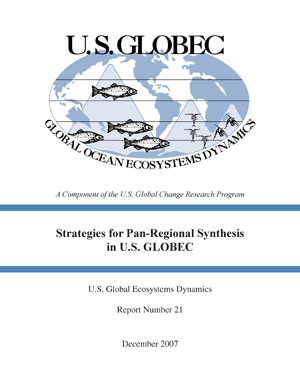U.S. GLOBEC Synthesis
The goal of U.S. GLOBEC is to understand how physical processes affect the structure and dynamics of marine ecosystems and to predict the effects of climate change and variability on these systems. To meet this goal it will be necessary to effectively synthesize information derived from U.S. GLOBEC regional programs in the Northwest Atlantic/Georges Bank region, the Northeast Pacific, and the Southern Ocean in the form of quantitative models and to undertake pan-regional synthesis activities based on a comparative analysis among U.S. GLOBEC regional programs and other marine ecosystem research programs.
The framework for synthesis in U.S. GLOBEC regional programs entails the integration of information derived from individual studies within each using coupled physical-biological models. Necessary precursors to this integration include the development of intermediate synthesis products from primary data. Also needed are gap analyses in which the needs for model parameterization are evaluated in relation to data collected within the individual programs. Regional synthesis efforts now underway are critical building blocks of synthesis for the program as a whole. Report number 21 (right) reviews the modeling approaches now being employed as synthetic tools in individual U.S. GLOBEC programs, advances in topics such as data assimilation and model skill assessment, and the prospects for fuller integration of climate forecasts and GLOBEC coupled physical-biological models.
The importance of comparative analysis in U.S. GLOBEC for pan-regional synthesis has been recognized from the inception of the program. Comparison of the dynamics of closely related taxa selected as target species in relation to specific physical processes (including stratification, mechanisms of retention and loss, upwelling and downwelling, and cross-front exchange) will be an integral component of the overall synthesis and integration effort in U.S. GLOBEC. Comparisons of closely related species within regions in relation to these physical processes will also be employed in conjunction with comparisons across system types to examine the effects of climate forcing on marine ecosystem structure and function.
The commonality of modeling approaches applied in U.S. GLOBEC regional studies provides opportunity for synthesis and comparison across systems and taxa. The convergence toward application of similar 3-D circulation models in each of the areas and the recognized importance of applying a common nested modeling strategy in each of the areas at the basin scale will facilitate model intercomparisons of key hydrodynamic forcing mechanisms. Similarly, in each of the U.S. GLOBEC study areas the same general classes of biological/ecological models have been applied including individual-based models for target taxa and simple ecosystem models such as NPZ(D) structures. The biological models for the target species employ a “middle-out” (or ‘rhomboidal’) modeling approach where focus is placed first on the taxa or trophic level of primary interest, with decreasing resolution in detail in the links up to predators and down to prey. This structure relies on providing necessary detail of the model for the target species and requires diminishing detail of neighboring trophic levels.
Facilitating synthesis activities in U.S. GLOBEC will involve:
- Adoption of calls for synthesis proposals in U.S. GLOBEC to allow for adjustment in relation to progress and perceived needs,
- Annual data and synthesis workshops for GLOBEC investigators with the goal of linking observations to models,
- Examination of all GLOBEC-funded projects in relation to requirements for modeling and synthesis to ensure full utilization,
- Assembling teams of modelers and field researchers to address requirements for model development,
- Continued development of special journal issues devoted to U.S. GLOBEC,
- Holding Special Sessions at national and international meetings devoted to U.S. GLOBEC results, and
- Holding Special Symposia devoted to U.S. GLOBEC results.
- Special issues of journals devoted to U.S. GLOBEC. In the past, GLOBEC results have been presented as special volumes in Deep Sea Research, (Part II), Progress in Oceanography, and Oceanography.
- Multi-authored books for each region with chapters aimed at broad synthesis in identified topic areas. A book devoted to pan-regional synthesis in U.S. GLOBEC would complete the series.
- Contributions to ecosystem-based management based on GLOBEC findings and the transfer of operational monitoring and modeling capabilities to agencies involved with resource management.



